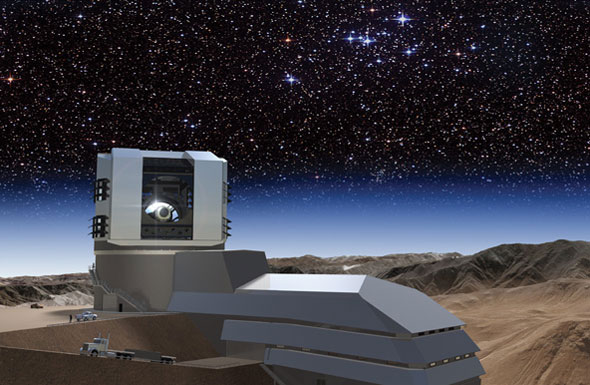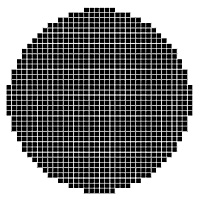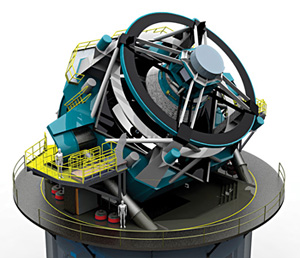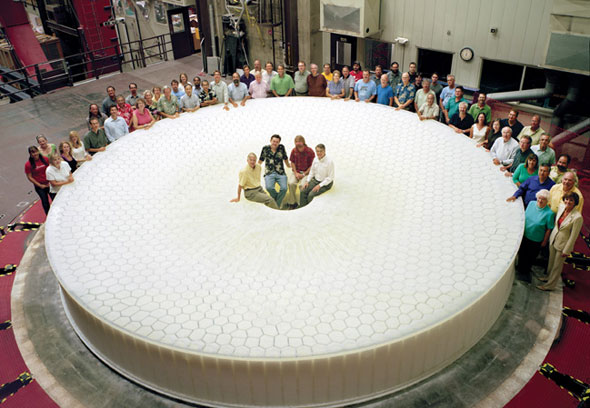The LSST's supersized sweep of the sky
The Large Synoptic Survey Telescope, which will plumb a bigger volume of the universe than any survey before it, isn't just a challenge for astronomers. It also requires the expertise of high-energy physicists, who play key roles in advancing the flourishing field of survey astronomy.
By Calla Cofield
 |
| A digital illustration of the completed LSST facility. Illustration: Todd Mason Productions |
 |
The LSST is Large—that's what the L stands for. The SS stands for Synoptic Survey, so it promises to look at every aspect of a very big whole. When it comes to the tools of physics research, high energy physicists reign over the very large. They build accelerators that stretch for miles, detectors the size of apartment buildings, data sets so big that no commercial database can hold them, and collaborations that rival the populations of small cities. The Large Synoptic Survey's scale gives it the ring of a giant particle physics project.
But the LSST's final letter is for Telescope, the canonical tool of astronomy. And the LSST, like its name, is a merger of high energy physics and astronomy. From the beginning, the two fields have joined forces to conceive, design, and build the giant telescope.
Atop Cerro Pachón in the Chilean Andes, far from city lights, airplane contrails, and cloud cover, the LSST will get a clear view of the night sky over the Southern Hemisphere. The telescope's camera will snap images as the instrument moves across the heavens, and every three days it will compile enough of them to create one cohesive portrait of the visible southern sky. Eventually researchers will stack all of those reproductions together to generate sky maps with increased resolution and sensitivity, containing distant galaxies never before seen in optical light. On top of that, when objects in the LSST's field of vision change in location or brightness, the telescope will issue an immediate alert to other telescopes and observatories—up to tens of thousands of alerts per night.
The LSST will surpass any previous ground-based telescope in the volume of the universe it surveys, the amount of data it generates, and the number of time-sensitive alerts it issues.
The LSST will also stretch itself beyond the traditional realm of observational astronomy. In fact, it was originally conceived as an instrument for studying dark matter and dark energy.
Dark matter is an unseen mass that fills the universe. Dark energy is an unexplained force causing the expansion of the universe to accelerate. Together dark matter and dark energy make up 95 percent of the universe, invisibly dominating the billions and billions of stars, planets and other clumps of so-called normal matter. Within the next decade, scientists hope to identify dark matter and to make progress in determining the nature of dark energy; both are major research focuses for the US Department of Energy's Office of High Energy Physics.
Right now, physicists studying dark energy need a vast increase in data, says Steve Kahn, a professor at Stanford University and SLAC National Accelerator Laboratory. SLAC is one of the leading institutions in the LSST Corporation, an independent entity established to manage the LSST project, for which Kahn is deputy project director.
The LSST will meet the need for dark energy data over its estimated 10-year lifetime by collecting some 2000 images of each of five billion galaxies.
But all that is yet to come. Right now the LSST Corporation is working to secure long-term government funding for the project. Thus far a mix of private and public funding has allowed construction to begin on many of the telescope's key components and permitted R&D on some of the camera's state-of-the-art elements. And an integrated community of physicists and astronomers has already formed to carry out the experiment, with particle physics offering crucial expertise.
Particle detectors and cameras
In terms of physical size, the LSST won't be the largest telescope ever built, but it will still break records. The combination of its large mirror area and the large section of sky captured in each image will make it the fastest sky survey telescope ever deployed.
 |
| A representation of the CCD chips to be used in the Large Synoptic Survey Telescope project. Each of the 200 chips has the capacity to take a 16 mega-pixel image. |
The LSST mirrors will capture and focus starlight down into the largest— and perhaps the most expensive—digital camera ever built. Six feet tall, weighing more than 6000 pounds, the LSST camera will produce 3.2-billion-pixel images and generate, on an average viewing night, about 15 terabytes of raw data, or 25,000 CDs worth. To display one of the LSST full-sky images on a television would require not just a high-definition screen, but 1500 of them.
Led by a team at SLAC, LSST collaborating institutions from all over the world are working on pieces of the camera.
This isn't the first time SLAC has contributed hardware for a telescope; a SLAC team built the Large Area Telescope, the main detection device for the Fermi Gamma-ray Space Telescope, now in its third year of orbit around Earth.
The 20 SLAC employees on the LSST camera team include Kahn, who is the camera project scientist, Project Manager Nadine Kurita, and System Scientist Kirk Gilmore. SLAC is overseeing the design of the camera body, shutter, focal plane detectors, camera data acquisition, and (along with a group in France) the filter changer. The camera will be assembled and commissioned at SLAC.
SLAC Professor of Physics Rafe Schindler is part of a team working on the camera cryostat, which will stabilize the CCD sensors—the eyes of the camera—and keep them sealed in a clean, high-vacuum environment at a temperature between minus 100 and minus 140 degrees Celsius. The focal plane structure that the CCD system rests on is about 65 centimeters in diameter. When assembled, the combined surfaces of the CCDs must be totally flat to within 10 microns, or less than half the width of a human hair.
 |
| A digital rendering of the LSST instrument, with human figures for scale. Image: LSST Corporation/NOAO |
It requires a lot of very state-of-the-art materials, and very state-of-the-art engineering, Schindler says. The problems we are solving are closer to what you see when you are building a modern particle physics detector or particle accelerator.
Schindler estimates that about half of the camera team members, himself included, come from particle physics. Often, he says, a team member brings specific experience to bear on a technical challenge. Among many other things, he says, the astrophysicists know the reality of the telescope environment, including the possibility of lightning strikes—something particle physicists who work with underground detectors don't usually face and might never consider. Particle physicists provide hardware expertise as well, but primarily, Schindler says, they have experience with large-scale technologies.
The tension is in the scaling up of the telescope, the sensors, the electronics, and the data, and I think that's where our particle physics experience comes in, Schindler says. The scale of the project is really the reason I and a lot of other particle physicists got interested in the LSST.
 |
Big data
All of the LSST's starry images will add up quickly. In fact, in its decade of operation the LSST will generate more than 100 petabytes of raw data, which is more than all other previous telescopes combined. Storing it will be a challenge.
For high-energy physics, pushing the data-storage envelope is not new. For astronomy, a database of this size is truly a first, and it will change the way many astronomers do research.
It used to be in astronomy that you take data on a telescope for a few nights, put your data on a CD and go analyze it on a laptop, says Jeff Kantor, LSST's data management project manager. With the LSST you just can't do that.
SLAC computer scientists Jacek Becla, Kian-Tat Lim, and Daniel Wang are responsible for the LSST data access and database system.
The largest commercial databases now on the market have just begun to manage petabytes of data (1015 bytes, or 1000 terabytes). But large particle physics experiments produce more data than even the largest commercial databases can manage, as will the LSST. So, computer scientists must build those databases in-house.
Building an extremely large database is akin to building a skyscraper: it isn't as simple as stacking 100 single-story buildings on top of each other. The increase in data volume multiplies standard challenges and presents entirely new ones. At the top of the list is how to search gigantic databases in a finite time. Computer scientists have found ways to divide the data so that a single search can use many computers simultaneously to look for the desired data.
But unlike the case of high energy physics experiments, where each particle collision is independent from the others, the LSST data contains correlations in space and time. Queries to the database may request information not only for a single star in a single image, but also information for that star at other times and in relation to nearby stars. This makes it much more difficult to divide the data across multiple computers. Becla and Lim say they have made important strides, some of them new to database science, yet this remains their toughest task.
None of us have dealt with tens of petabytes of data before, but we aren't really scared by the numbers, Becla says. Storing and retrieving a few petabytes is not that hard these days. It is the data complexity and understanding complex interactions between billions of data points that present the biggest challenge.
Scaling up fast
Right now the LSST project has about 400 members and expects to grow to more than 1000. Its predecessor, the Sloan Digital Sky Survey, another cutting-edge optical survey telescope, had 300-plus members. Compare that to particle physics experiments such as Fermilab's CDF, which has more than 600 members, the BaBar Collaboration at SLAC which at one point had 2000 members, or to experiments operating at CERN's Large Hadron Collider, the largest of which has exceeded 3000 members. Major particle physics experiments gradually evolved to these large sizes, learning over time how to manage the experiments and the large collaborations that operate them; but astronomy has no such previous experience.
 |
| Members of the LSST corporation in 2008 with the completed cast, or blank, used to form the telescope's 27.5-foot-diameter primary mirror. The cast itself weighs 51,900 pounds. Photo: Howard Lester/LSST Corporation |
Astronomers have never had to deal with one of these truly gargantuan projects, says Tony Tyson, current LSST director. It demands a higher level of discipline and accountability because there are so many people involved. Particle physics has had to get used to that—there's a culture of that—and I think they bring that to the LSST.
Effective management of a large experiment requires that many experienced scientists dedicate themselves to leadership positions rather than to research. One central issue that needs constant managerial attention at this stage in the LSST's growth is funding.
Much of the initial funding to get the LSST rolling came from private sources, primarily the Charles Simonyi Fund for Arts and Science and from Microsoft founder Bill Gates. But no single private funder, government agency, or university could provide the LSST's entire budget. And joining forces to pay for the LSST creates challenges for government agencies, which must clearly delineate and coordinate their roles.
Long-term plans show the bulk of LSST funding coming from the National Science Foundation and the US Department of Energy. Astrophysics in the US has traditionally been principally funded by NASA and NSF's Division of Astronomy, while particle physics gets most of its funding from DOE, with important contributions from the Mathematics and Physical Sciences (MPS) Division of NSF. And there isn't a funding agency that owns the overlap between particle physics and astronomy, says Kahn.
The choice of SLAC as primary builder of the LSST camera not only takes advantage of the lab's expertise, but also defines which portions of the project are funded by the DOE and by NSF's MPS division. Now the SLAC-based construction of the database falls under the same umbrella.
A field of their own
By the summer of 2010, the LSST had been under serious study for nearly 10 years, but US funding agencies had still not determined its future. To move forward, the LSST needed a definitive show of community support.
The make-or-break moment came with the release of Astro2010, the National Research Council's Astronomy and Astrophysics Decadal Survey. Endorsed by the astronomy community, the survey compiles and ranks current and potential projects in astronomy and astrophysics over a 10-year period, according to their value and importance to the community. The LSST came out at the top of the list of new ground-based facilities.
The LSST's ambitious scientific agenda appears to have won the favor of researchers in astronomy, astrophysics, and particle physics; and now it seems to be working to bring those disciplines closer together. Most of those interviewed for this article pointed out that many people within the collaboration do not identify with just one of these fields. Some said their job titles switch from field to field depending on the day of the week. Some, like Schindler, define themselves by specialized roles with no preference for scientific discipline, yet that are essential for these experiments. In theoretical circles, many of these areas have already blended, and survey astronomy provides a similar melting pot for experimentalists.
Some people would argue that the whole field of survey astronomy is a new field unto itself; that it is a canonically different way of doing science compared to traditional astronomy, Kahn says. And maybe that community exists unto itself, because it wasn't always so rooted in one culture or another.
The students who worked on the Sloan Digital Sky Survey have now joined the larger scientific community in post-doctoral and faculty positions. With the LSST, even more scientists will start their careers in survey astronomy—a melting pot of computer science, particle physics, astrophysics, and astronomy.
Click here to download the pdf version of this article.






